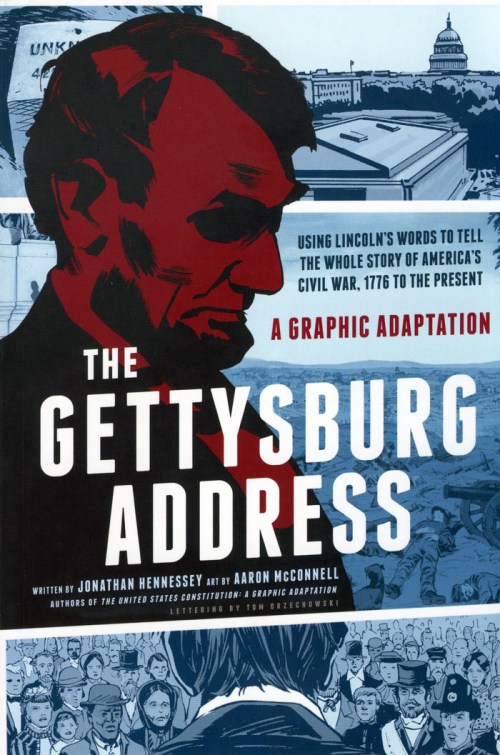
It was on a bright day in January in 1865 that the United States, despite feverish opposition, passed the 13th Amendment and abolished slavery in the land. The fight to outlaw slavery, once and for all, is the focus of Steven Spielberg’s “Lincoln.” Even if the final outcome is already known to the audience, the full story will likely be new. Remarkably, this film, with its familiar director and familiar subject, feels new too. This is a 21st Century Lincoln led by Daniel Day-Lewis’s brilliant interpretation of a man of his time with a keen sense for the timeless.
Mr. Spielberg uses his Lincoln capital wisely as we begin this film. After some scenes of bloody fighting, we cut to a close-up of two African American infantrymen. They are being interviewed about the Civil War. One man seems content. The other lists the injustices suffered by his people. The interviewer is Pres. Lincoln. We then float up to a dreamworld and there’s the tall and lonely figure in a stovepipe hat standing on the bow of a vast ship. Restraint. Elegant restraint. “Lincoln” proves to have the elegant restraint to make such a movie.
After all the hype, and there’s more to come, “Lincoln,” proves to be a very engaging film. It is not a Frank Capra treatment of our 16th president and that is an understandable concern. As we now know, Daniel Day-Lewis turned down more than one screenplay for this film. The one that finally won him over is based on the book, “Team of Rivals,” by Doris Kearns Goodwin and adapted for the screen by Tony Kushner. It provided a way to maintain that elegant restraint that Mr. Day-Lewis knew was essential.
With the sense of urgency clearly stated, we see a president determined to use all his political capital to steer the country in the right direction. In short order, he means to legitimize his Emancipation Proclamation. The only way to end slavery in the United States is to pass a Constitutional Amendment and the only way to do that is to act immediately. For political junkies, the ensuing dramatization is nirvana. You can almost hear Doris Kearns Goodwin reciting from her popular book in the background. However, this film does offer much more. There is a special urgency you feel in the filmmaking. When Lincoln speaks, everyone listens. We see a jaw drop a bit when the president exercises his distinctive skill to make a point. We feel history being made in a refreshing way as all the players are allowed to live and breathe.
At one point in the film, we see Mr. Day-Lewis in an scene where he ponders over Euclid, the ancient Greek mathematician. It is during a pivotal moment in the war that Lincoln thinks out loud with a couple of young staffers. One of them says he’s an engineer by profession. This sparks Lincoln to quote some Euclidean geometry, “Any two sides that are equal to the whole are equal to each other. Euclid, three thousand years before, stated that this was self-evident.” It is a delightfully low-key moment, one of many, that Mr. Day-Lewis plays masterfully.
In keeping with the restrained vibe in this film, we follow the journey of radical Republican, Thaddeus Stevens, played by Tommy Lee Jones. At first, we don’t seem to know which side he’s on or whether he can be relied upon to check his ego at the door when he needs to. It’s a great performance. One particularly good scene is when he’s confronted by the First Lady, played by Sally Field. She is greeting visitors at a reception and seizes the opportunity to put Stevens in his place. Coming across as a Hillary Clinton complaining over Whitewater investigations, she chides Stevens for his investigating her overseeing renovation of The White House. We see that Stevens can take a good chiding and take it to heart.
The Spielbergian touch is most evident in what we see from a child’s point of view in this film. There was a little boy who lived in the White House, the President’s son, Tad Lincoln. He’s there so often in the film as to be its anchor, conscience, and sense of innocence. When Lincoln and his men gather for a war meeting, the war map is found to have suffered a burn at one corner. Tad Lincoln was there. When Lincoln is patiently awaiting the final vote of the 13th Amendment, he is entertained by Tad Lincoln building a monument from various books and legal briefs. When Lincoln needs to keep up his sense of purpose, all he needs to do is observe the photographs of slaves that Tad Lincoln has been observing. And, when the President is shot, it is Tad Lincoln’s sorrow we focus upon. This is not Doris Kearns Goodwin’s or Daniel Day-Lewis’s doing. This is Steven Spielberg’s.
Like this:
Like Loading...



























